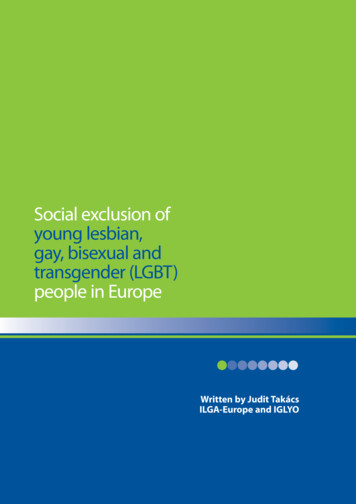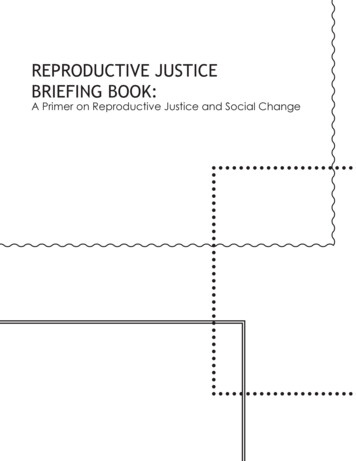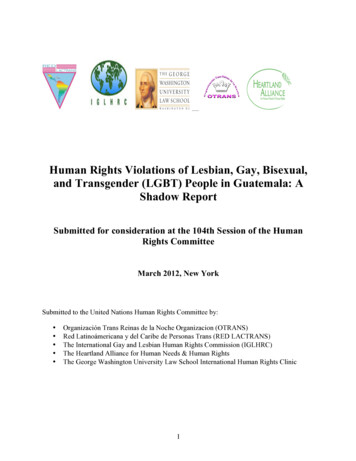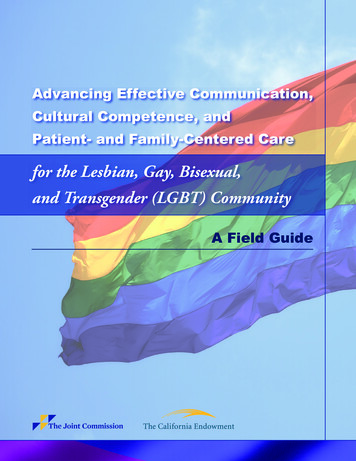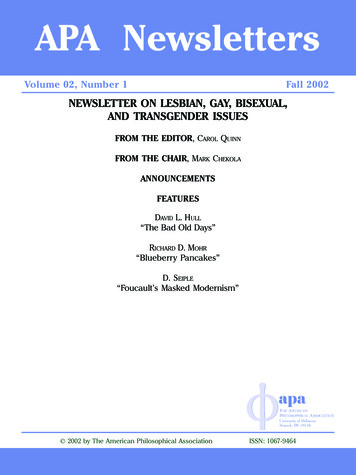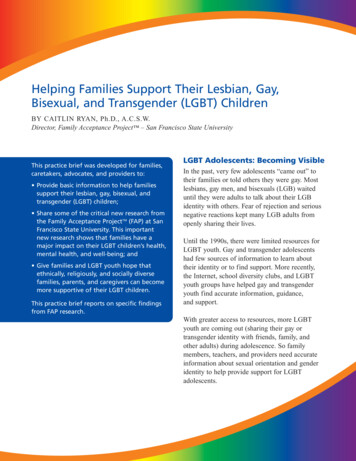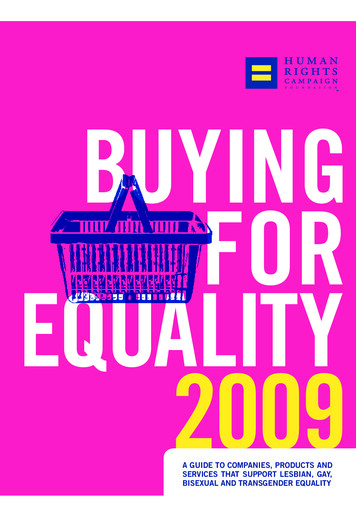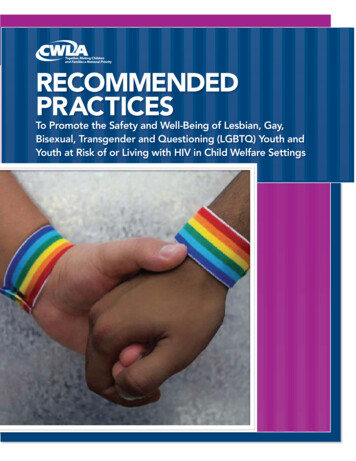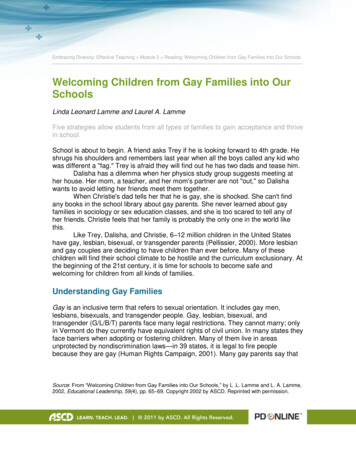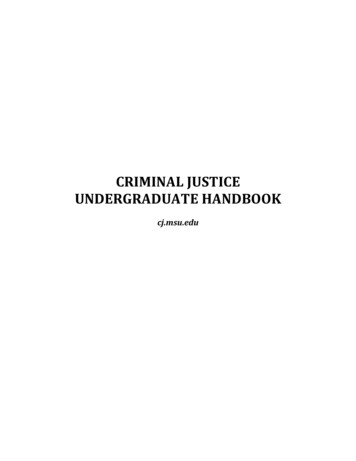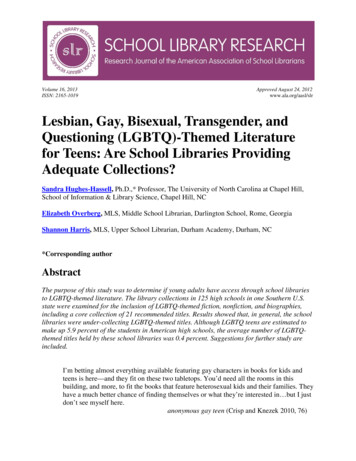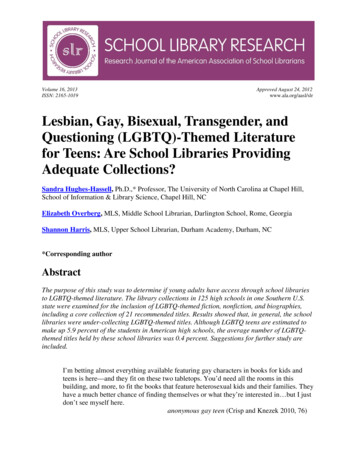
Transcription
Volume 16, 2013ISSN: 2165-1019Approved August 24, 2012www.ala.org/aasl/slrLesbian, Gay, Bisexual, Transgender, andQuestioning (LGBTQ)-Themed Literaturefor Teens: Are School Libraries ProvidingAdequate Collections?Sandra Hughes-Hassell, Ph.D.,* Professor, The University of North Carolina at Chapel Hill,School of Information & Library Science, Chapel Hill, NCElizabeth Overberg, MLS, Middle School Librarian, Darlington School, Rome, GeorgiaShannon Harris, MLS, Upper School Librarian, Durham Academy, Durham, NC*Corresponding authorAbstractThe purpose of this study was to determine if young adults have access through school librariesto LGBTQ-themed literature. The library collections in 125 high schools in one Southern U.S.state were examined for the inclusion of LGBTQ-themed fiction, nonfiction, and biographies,including a core collection of 21 recommended titles. Results showed that, in general, the schoollibraries were under-collecting LGBTQ-themed titles. Although LGBTQ teens are estimated tomake up 5.9 percent of the students in American high schools, the average number of LGBTQthemed titles held by these school libraries was 0.4 percent. Suggestions for further study areincluded.I’m betting almost everything available featuring gay characters in books for kids andteens is here—and they fit on these two tabletops. You’d need all the rooms in thisbuilding, and more, to fit the books that feature heterosexual kids and their families. Theyhave a much better chance of finding themselves or what they’re interested in but I justdon’t see myself here.anonymous gay teen (Crisp and Knezek 2010, 76)
LGBTQ-Themed Literature for TeensVolume 16 ISSN: 2165-1019IntroductionUnder the very best of conditions, navigating adolescence can often be a confusing, lonely, andoccasionally overwhelming experience, as teens seek to find their way between the expectationsothers have for them, both peers and adults, and the drive to lay claim to their newly independentself. Navigating adolescence is a process of exploration and experimentation, of tentativediscovery and evolving self-understanding. Identity formation, the main task of adolescence,requires a relatively safe and supportive framework within which adolescents can come to knowtheir true selves (Hughes-Hassell and Hinckley 2001). For heterosexual adolescents, manyavenues of support exist: family, friends, school, and the community (Sears 1991). Identityformation is a much more difficult task for most lesbian, gay, bisexual, transgender, andquestioning (LGBTQ) youth. These young adults often come of age in communities where fewgay adults are visible, attend schools that have no openly gay staff, and interact with peers whouse “fag” and “dyke” as the favored insult and “that’s so gay” as a common put-down (Kosciw etal. 2012; Sears 1991). In this environment LGBTQ adolescents struggle with the decision of notjust who they are, but whether they are, and who they dare tell about it. Not surprisingly, manyLGBTQ youth fear that candor will bring only rejection, and struggle through adolescencefeeling completely isolated and alone (Ryan and Futterman 1998).Compounding their feelings of isolation are often concerns for their safety. Despite increasingsocietal acceptance of gay rights, the LGBTQ community remains—by far—the minority mosttargeted in hate crimes (Potok 2010). According to the 2011 National School Climate Surveyconducted by the Gay, Lesbian and Straight Education Network (GLSEN), 63.5 percent ofLGBTQ students said they felt unsafe in school because of their sexual orientation. Seventypercent had experienced anti-gay bullying, with 38.3 percent reporting that they had beenphysically harassed (e.g., shoved or pushed) and 18.3 percent reporting being the victim ofphysical assault. LGBTQ students in rural areas and small towns were less safe in school thanstudents in urban and suburban areas (Kosciw et al. 2012).The impact of homophobia and anti-gay bullying on LGBTQ students is not limited to theirfeelings of safety. The same 2011 National School Climate Survey (Kosciw et al. 2012) revealedthat LGBTQ students who were harassed because of their sexual orientation and genderexpression had significantly lower grade-point averages than their peers did (2.9 vs. 3.2).Increased victimization also leads to increased levels of depression and anxiety and to decreasedlevels of self-esteem in LGBTQ students. The isolation and despair LGBTQ youth experienceplaces them at high risk for a variety of other problems including homelessness, substance abuse,and suicide (Ryan and Futterman 1998). One study found that LGBTQ teens were over fourtimes more likely than their peers to attempt suicide (Massachusetts Dept. of Ed. 2009).LGBTQ youth, just like heterosexual teens, must have opportunities for self-affirmation andsocialization if they are to develop into healthy adults (Kosciw et al. 2012). Many local, state,and national organizations provide LGBTQ youth with opportunities to connect with otherLGBTQ youth and to interact with positive gay adult role models, but locating these programs isoften difficult for teens. Many LGBTQ youth are hesitant to ask adults for information aboutLGBTQ organizations, and in many communities, these organizations are nonexistent.So where can young people who identify as LGBTQ turn for support, safe space, confidentialaccess to information, and materials that speak to their lives? School and public libraries.Research by Linda B. Alexander and Sarah D. Miselis shows that the library is “the mostimportant information source” for LGBTQ people (2007, 45). Library resources can provide self2School Library Research www.ala.org/aasl/slr
LGBTQ-Themed Literature for TeensVolume 16 ISSN: 2165-1019affirmation, offer characters with which to identify, and decrease the feeling of alienation (Rauch2010). Additionally, studies show that “when a young lesbian, gay, bisexual, transgender orquestioning (LGBTQ) teen knows there is an affirming teacher, school nurse, clergy member orparent they can trust, they are much more likely to turn to them for help when they are bullied ordepressed” (GLSEN 2010).The mission of the school library is “to ensure that students and staff are effective users of ideasand information” (AASL 2009, 8). This mission can be interpreted narrowly to mean schoollibraries should collect primarily materials that support the classroom curriculum. While theincreased national focus on the Common Core and Race to the Top, combined with budget cuts,may seem to justify this stance, research has shown that the “essence of teens’ everyday lifeinformation seeking is the gathering of information to facilitate their teen-to-adult maturationprocess” (Agosto and Hughes-Hassell 2006a, 1394). In a 2011 report, the National Center forMental Health Promotion and Youth Violence Prevention argues that schools must help youth“recognize and manage their emotions, appreciate the perspectives of others, establish positivegoals, make responsible decisions, and handle interpersonal situations effectively” (2011, 6).Additionally, many school districts have mission statements that promote multiculturalism anddiversity, both in the curriculum and the library (Curwood 2009). Thus, it would seem that tosupport the full range of teens’ information needs, school libraries must expand their collectionsbeyond curricular-related materials to include resources that address teens’ social, emotional,physical, and sexual needs (Agosto and Hughes-Hassell 2006b). In “Access to Resources andServices in the School Library Media Program: An Interpretation of the Library Bill of Rights,”the ALA Council concurs, stating that school library resources should “include materials thatsupport the intellectual growth, personal development, individual interests, and recreationalneeds of students” (ALA 2008). As Elisabeth W. Rauch points out in a recent article in TeacherLibrarian, school “librarians can provide [LGBTQ] materials and even programming with theknowledge that they are doing so out of professional responsibility” (2011, 14).Unfortunately, few school libraries appear to be providing LGBTQ-themed resources. Less thanhalf (44.1 percent) of the 8,584 students surveyed in the 2011 National School Climate surveyreported that they could find information about LGBTQ-related issues in their school library.Students in the South were the least likely to report access to these resources (Kosciw et al.2011).How accurate are student perceptions? How well are school libraries providing resources forLGBTQ teens, especially at this critical transitional time in their identity development? Severalstudies have analyzed public libraries’ holdings of young adult LGBTQ resources (Boon andHoward 2004; Spence 1999; Rothbauer and McKechnie 1999; Stringer-Stanback 2011), yet nonehave focused on school libraries’ holdings (Clyde and Lobban 2001). The majority of schoollibrary-related articles about LGBTQ issues and resources deal with censorship and policy issues(e.g., Schrader 2009; Storts-Brinks 2010), offer lists of recommended resources (e.g., Clyde andLobban 2005; Rauch 2010),or provide strategies for making school libraries safe places forLGBTQ teens (e.g., Cuseo 2012; Manfredi 2009; Rauch 2010; Schrader 2007). To address thisresearch gap, we analyzed the library collections of 125 high schools in one Southern U.S. statefor the inclusion of LGBTQ-themed books (fiction, nonfiction, and biographies). This articlediscusses the issues underlying the research, and presents the methodology and results of ouranalysis. While our study focused on only high schools in one state, the research could easily bereplicated in any other state or region using the same methodology.3School Library Research www.ala.org/aasl/slr
LGBTQ-Themed Literature for TeensVolume 16 ISSN: 2165-1019Literature ReviewRole of Books in the Lives of LGBTQ TeensLGBTQ teens are at risk when they can’t find materials to help them feel included in theircommunity. Resources can provide self-affirmation, offer characters with which to identify, anddecrease the feeling of alienation (Rauch 2011). Citing research by Linda B. Alexander andSarah D. Miselis (2007), and Hillias J. Martin and James R. Murdock (2007), Elisabeth W.Rauch (2010) concluded that LGBTQ-themed literature provides LGBTQ teens with theopportunity to understand what it means to be queer, to learn gay social norms, to vicariouslyexperience the coming out process, to know they are not alone, to connect with others like them,to find positive role models, and, perhaps most importantly, to affirm the fact that they arenormal.Annemarie Vaccaro, Gerri August, and Megan S. Kennedy (2012) have argued that whenLGBTQ youth see themselves reflected positively in literature they feel a sense of belonging andinclusion. Alternatively, feelings of invisibility can occur in the absence of positive LGBTQimages. In addition to a lack of positive LGBTQ characters in literature, a lack of LGBTQthemed books sends a message to youth that it is not okay to be gay, bisexual, transgender, orlesbian. These teens may have access only to literature that reinforces heterosexism andtraditional gender stereotypes, sending additional messages that the teens’ feelings are wrong.“Sometimes books can be the only safe place to learn about LGBT [Q] issues or to find rolemodels” (2012, 19). To illustrate this point, Vaccaro, August, and Kennedy introduced “Laurie,”who struggled with her same-sex feelings and had no one to talk to. She turned to her librarianfor support and read everything the librarian gave her.Having access to books with LGBT [Q] characters and positive LGBT [Q] messages wasinvaluable [emphasis added] to Laurie’s safety and identity development. The storieshelped her learn that she was not alone in her same-sex feelings.These fictionalcharacters helped her persist in a home and school environment where she never fit it. Inbooks, however, she always felt affirmed and safe (2012, 130).Quality LGBTQ-themed literature can have a positive impact on the entire school community,not just teenagers with same-sex orientation. By collecting tales of friendship, companionship,and romance, school librarians can “help to create a more complete portrait of the life of anLGBT [Q] teenager” (Manfredi 2009, 28). Angie Manfredi has argued that familiarity withLGBTQ-themed literature can help all teens understand what it means to have gay friends,family members, classmates, peers, colleagues, and acquaintances. She outlined a process called“advocating and integrating” (2009, 8), in which school librarians do not just add LGBTQthemed titles to the collection, but actively promote them by featuring them on reading lists,including them in displays, booktalking them, recommending them to teachers for inclusion inthe curriculum, and including them in library-sponsored book clubs.Public Libraries’ Holdings of LGBTQ Young Adult BooksA number of studies have looked at public libraries’ holdings of LGBTQ young adult fiction andnonfiction. In 1999 Alex Spence checked a list of ninety-nine young adult novels with LGBTQcontent recommended by Christine Jenkins (1993, 1998) against the holdings of ten U.S. andnine Canadian urban public library systems’ Online Public Access Catalogs (OPACs). The4School Library Research www.ala.org/aasl/slr
LGBTQ-Themed Literature for TeensVolume 16 ISSN: 2165-1019holdings varied across the libraries with some having substantial collections and others havingonly a few of the titles. His findings were supported by Paulette M. Rothbauer and Lynne E. F.McKechnie (1999) who used a random sample of forty titles from the same authoritative sourceto check the holdings of forty large- and medium-sized Canadian public libraries. The findings oftheir study showed that access to gay and lesbian fiction for young adults in Canadian publiclibraries was somewhat limited and inconsistent, even when the size of the library wasconsidered. Additionally, more recent titles that presented the theme of homosexuality in apositive way were no more likely to be held than older titles that often portray negativestereotypes.In 2004 Michele H. Boon and Vivian Howard published an article looking at the availability ofthirty-five recent LGBTQ fiction books for teens compared to availability of a control group ofrandomly selected non-LGBTQ young adult fiction titles in nine Canadian public libraries. Therandomly-selected titles were held in much greater quantities than LGBTQ titles. For example, acopy of a randomly-selected title without LGBTQ content was approximately 70 percent morelikely to be purchased by these libraries than a copy of a title with LGBTQ content.Shifting the focus to nonfiction, Kynita Stringer-Stanback (2011) examined the holdings of thepublic libraries in five southeastern U.S. states; she looked for availability of twenty-three youngadult nonfiction titles, a group compiled from literary-award winners. She hypothesized thatcounties with anti-discrimination ordinances would be more likely to have young adult LGBTQnonfiction materials in their libraries. She found that only 25 percent of the counties examinedheld 50 percent or more of the titles, and that the number of titles held was not related to whetherthe county had an anti-discrimination ordinance. While her findings did not validate herhypothesis, they did show that the public libraries in the more demographically diverse countieshad more LGBTQ titles.Current StudySampleThe sample included 125 high schools, or roughly 28 percent of the public high schools in oneSouthern state in the U.S. 1 The state is described as in political transition. President Obamanarrowly won the state in 2008, and Democrats hold eight of the state’s thirteen Congressionaldistricts. Thirty-three of the state’s one hundred counties are considered to be “blue” counties.Although the state, like all Southern states, has a constitutional amendment banning same-sexmarriage, the state is considered to be relatively moderate on social issues. For example, manymunicipalities and private businesses in the state provide benefits to domestic partners. In the2010–2011 school year the state adopted a comprehensive reproductive health and safetyprogram that promotes abstinence as the best method for avoiding pregnancy and sexuallytransmitted infections (STIs), but also teaches about contraception, safe sex, and healthyrelationships, effectively ending a decade-long policy of abstinence-only sex education.The state’s Department of Public Instruction divides the state into eight (unequal) geographicregions. For inclusion in the study, we selected every third school on a list of schools in eachregion, ensuring that our sample would equally represent all of the geographic regions of the1The sources of information included in this paragraph about the state are not cited because the authors do not wishto identify the state. The corresponding author may be contacted with questions or to provide further information.5School Library Research www.ala.org/aasl/slr
LGBTQ-Themed Literature for TeensVolume 16 ISSN: 2165-1019state. If a school library’s OPAC could not be searched remotely (or the school did not have anOPAC), we selected another school from the same region, ensuring that the sample stillcontained the same number of schools in the state and representation from each region.MethodologyAfter the sample was identified, we searched the OPAC of each of the 125 high school librariesto determine the number of LGBTQ-themed fiction, nonfiction, and biographies held. Toidentify the titles, we used the Sears (2010) subject headings: “homosexuality,” “gay men,”“lesbians,” and “transsexualism.” For each title found, we recorded (on a spreadsheet) the author,title, and copyright date.We also checked for the inclusion of a core collection of highly recommended LGBTQ-themedliterature as other researchers (Boon and Howard 2004; Spence 1999; Rothbauer andMcKenchnie 1999; Stringer-Stanback 2011) had in their studies of public library holdings. Thecore collection was identified using Gay, Lesbian, Bisexual, Transgender and Questioning TeenLiterature: A Guide to Reading Interests by Carlisle K. Webber (2010). This volume wasselected based on reviews in School Library Journal, Young Adult Library Services, and Booklistthat described it as: “A sound purchase for public libraries but especially useful for high-school librarians”(Welton 2010, 74);“A welcome guide for librarians who want to diversify their collections with currentmaterials” (Evans 2010, 112);A “well-written and relevant” resource that provides “core lists of five, ten, and fifteenrecommended titles that will quickly round out collections” (Thogersen 2010, 42).Webber’s guide discusses the importance of selecting books that present positive and accurateportrayals of the LGBTQ community, and the book provides a recommended list of fifteenLGBTQ young adult fiction titles and six nonfiction titles that she believes every high schoollibrary should collect. The titles include lesbian, gay, bisexual, transgender, and questioningthemes or content. By searching the library OPACs, we determined which of these titles and howmany copies of each title the school libraries in the sample currently hold.For each school in our sample we also recorded the size of the school’s student body, as well asthe number of books in the library collection. This data was gathered from the Department ofPublic Instruction’s website.FindingsNumber of LGBTQ-Themed Books in the School Library CollectionsAs figure 1 shows, the number of LGBTQ-themed fiction and nonfiction (including biographies)per school ranged from 1 to 157. Half of the schools (50 percent) held fewer than 31 titles; only22 percent of the schools held more than 50 titles. The average number of titles held was 35.7.Across the sample, LGBTQ-themed titles made up an average of 0.4% of each library’s totalcollection. Five outliers were identified. LGBTQ-themed titles made up 1.7, 3.9, 0.92, 1.4, and2.3 percent of their collections. Three of the outliers serve small nontraditional high schools. Theother two are located in communities that are considered to be liberal: one in a large metropolitanarea, the other in a small university town.6School Library Research www.ala.org/aasl/slr
LGBTQ-Themed Literature for TeensVolume 16 ISSN: 2165-1019Figure 1: Number of LGBTQ-themed titles per school.Number of LGBTQ Titles Per School180160140120100806040200Schools (n 125)As a whole, the schools collected more LGBTQ-themed fiction titles (2,616) than nonfiction(1,383) and biographies (285) combined. However, as figure 2 shows, while one school held 76different LGBTQ-themed novels, another held none. Only 6.4 percent, or 8, of the schools had50 or more LGBTQ-themed fiction titles in their collections. The average number of titles heldwas 20.8.Figure 2. Number of LGBTQ-themed fiction per school.Number of LGBTQ-Themed Fiction Titles80706050403020100Schools (n 125)Figures 3 and 4 show the number of LGBTQ-themed nonfiction titles and biographies held byeach school. Of the schools studied, 52 percent held fewer than 10 LGBTQ-themed nonfictiontitles, while 3 of the schools had no LGBTQ-themed nonfiction. Only 17 schools, or 13.6percent, held 20 or more LGBTQ-themed nonfiction titles in their collection. The averagenumber of titles held was 11.1.Of the schools studied, 109 (87.2 percent) had fewer than 5 biographies with subject headingsindicating that they were about LGBTQ individuals, with over one-fourth (27.2 percent) holding7School Library Research www.ala.org/aasl/slr
LGBTQ-Themed Literature for TeensVolume 16 ISSN: 2165-1019none. Only 2 schools had more than 10 LGBTQ biographies. The average number of titles heldwas 2.Figure 3: Number of LGBTQ-themed nonfiction titles per school.Number LGBTQ-Themed NonfictionTitles Per School706050403020100Schools (n 125)Figure 4: Number of titles about LGBTQ people per school.Number of Titles About LGBTQ PeoplePer School2520151050Schools (n 125)Number of Recommended Core Collection TitlesAs discussed above, we also checked each OPAC for the inclusion of a core collection of highlyrecommended LGBTQ-related fiction and nonfiction, identified in Webber’s Gay, Lesbian,Bisexual, Transgender and Questioning Teen Literature.The majority of the schools (65.3 percent) held fewer than 5 of the fiction titles. Almost one-fifth(19.3 percent) held none of the novels. Only 5.3 percent, or 7 schools, had more than 10 of thetitles in their collections. As shown in table 1, the title that was held by the most schools (59.2percent) was The Perks of Being a Wallflower. The title that was held the least was Down to theBone, a title that features a Cuban American lesbian teen.8School Library Research www.ala.org/aasl/slr
LGBTQ-Themed Literature for TeensVolume 16 ISSN: 2165-1019Table 1: Recommended LGBTQ young adult fiction held by the schools.TitleChbosky, Stephen. The Perks of Being a Wallflower(1999)Wittlinger, Ellen. Hard Love (1999)Freymann-Weyr, Garret. My Heartbeat (2002)Garden, Nancy. Annie on My Mind (1982, 1991,1992, 2007)Hartinger, Brent. Geography Club (2003)Levithan, David. Boy Meets Boy (2005)Peters, Julie Ann. Luna (2004)Bauer, Marion Dane. Am I Blue? Coming Out fromthe Silence (1994)Sanchez, Alex. Rainbow Boys (2001)Ryan, Sara. Empress of the World (2001)St. James, James. Freak Show (2007)Howe, James. The Misfits (2001)Burd, Nick. The Vast Fields of Ordinary (2009)9Recommended*Webber, YALSABBYA, Senior HighCore CollectionWebber, LambdaLiterary Award, PrintzAward, SLJ BestBooks, YALSABBYA, Senior HighCore CollectionWebber, Printz Award,SLJ Best Books,YALSA BBYA,Senior High CoreCollectionWebber, YALSABBYA, Senior HighCore CollectionWebber, LambdaLiterary Award, SeniorHigh Core CollectionWebber, LambdaLiterary Award,YALSA BBYAWebber, Rainbow List,Senior High CoreCollectionWebber, LambdaLiterary Award,YALSA BBYA,Senior High CoreCollectionWebber, LambdaLiterary Award,YALSA BBYA,Senior High CoreCollectionWebber, LambdaLiterary Award,YALSA BBYAWebber, Rainbow List,Lambda LiteraryAward, YALSABBYA, SLJ BestBooksWebberWebber, Rainbow List,Lambda LiterarySchool Library Research www.ala.org/aasl/slrNumber andPercentage of Schoolsthat Held the Title74 (59.2%)64 (51.2%)61 (48.8%)42 (33.6%)35 (28.0%)34 (27.2%)34 (27.2%)29 (23.2%)28 (22.4%)26 (20.8%)25 (20.0%)19 (15.2%)19 (15.2%)
LGBTQ-Themed Literature for TeensVolume 16 ISSN: 2165-1019Award, StonewallAwardWittlinger, Ellen. Parrotfish (2007)Webber, Lambda15 (12.0%)Literary Award, SeniorHigh Core CollectionDole, Mayra Lazara. Down to the Bone (2008)Webber, Rainbow List,12(9.6%)Senior High CoreCollection*This is an abbreviated list of best book reading lists and award lists on which these titles have appeared.As table 2 shows, even fewer of the schools held the recommended nonfiction young adult titles.Gay America: Struggle for Equality, which highlights the history of gays and lesbians in theU.S., was the most frequently held title, and it was collected by 12 percent of the schools. Only 6of the schools appeared to hold any of the recommended titles that focused on issues, such ascoming out or practicing safe sex, that are of concern to LGBTQ teens.Table 2. Recommended LGBTQ young adult nonfiction held by the schools.TitleAlsenas, Linas. Gay America: Struggle for Equality (2008)Levithan, David, and Billy Merrell, eds. The Full Spectrum: ANew Generation of Writing about Gay, Lesbian, Bisexual,Transgender, Questioning, and Other Identities (2006)Huegel, Kelly. GLBTQ: The Survival Guide for Queer andQuestioning Teens (2003)Marcus, Eric. Is It a Choice? Answers to the Most FrequentlyAsked Questions about Gay and Lesbian People (1993, 1999,2005)St. Stephen's Community House. The Little Black Book forGuys: Guys Talk About Sex (2008)St. Stephen's Community House. The Little Black Book forGirlz: A Book on Healthy Sexuality (2006)Number andPercentage ofSchools that Heldthe Title15 (12.0%)9 (7.2%)6 (4.8%)6 (4.8%)00DiscussionIt appears that the high school librarians in the public schools we studied are currently undercollecting LGBTQ-themed young adult literature. This finding is consistent with investigationsof public library holdings and supports the perceptions of students as reported in the 2011 SchoolClimate Survey. Although LGBTQ teens are estimated to make up 5.9 percent of the students inAmerican high schools (Massachusetts Dept. of Ed. 2009), the number of LGBTQ-themedfiction, nonfiction, and biographies held by these school libraries was minimal. A lack ofLGBTQ-themed literature in school libraries can send a message to LGBTQ teens that the schoollibrary is not the place for them, and that their lives and their concerns are not valued there.A lack of LGBTQ-themed titles is not only potentially damaging to LGBTQ teens, but to allteens. As Rauch points out, “access to stories with characters who may be like his/her classmatesor friends can help a teen reader be more empathetic and understanding as s/he experiencesvicariously the struggles and confusion many GLBTQ teens go through” (2010, 217). Lack of10School Library Research www.ala.org/aasl/slr
LGBTQ-Themed Literature for TeensVolume 16 ISSN: 2165-1019understanding and empathy can lead to insensitivity, bullying, and harassment, or even physicalabuse.Further research is needed to understand school librarians’ attitudes toward the role of schoollibraries in providing LGBTQ literature, as well as school librarians’ knowledge of the potentialthis literature has to make a difference in the lives of LGBTQ teens and in the overall climate oftheir schools.Contrary to our expectations, no trends in collection development among school districts orregions of the state were identifiable, suggesting that district- or state-level selection policieswere not at play in encouraging or preventing these school librarians from purchasing LGBTQthemed titles. The high school that held 157 titles, for example, was in the same school district(in a “blue” region of the state) and served the same demographic as the high school that hadonly 34 titles. Similarly, one school library in a “red” region of the state held 75 titles while theschool libraries in the surrounding “red” counties held on average only 27 titles. This finding wasin contrast to Stringer-Stanback’s (2011) finding that public libraries in more demographicallydiverse counties in Florida made more LGBTQ material available to their constituents.Some reasons for a conservative approach to collection development for LGBTQ teens mayinclude individual librarians’ attitudes, fear of challenges, or a perceived anti-gay culture in theschool and/or neighborhood surrounding the school. As Megan Schliesman (2009) explained, itis not uncommon for educators’ personal responses to the issues raised in LGBTQ-themedliterature, as well as real or perceived pressure from school administrators or the community, tointerfere with the inclusion of LGBTQ titles in schools. Rather than risk the negative publicitythat materials challenges bring, some school librarians may choose not to promote, or even tocollect, LGBTQ-themed literature. Rauch has pointed out that this failure is unacceptable, stating“even if you or others in your community do not agree with a particular lifestyle, the materialsabout that lifestyle cannot be excluded from the library’s collection” (2010, 217). Schliesmanagreed: one of the first steps every educator can take is to acknowledge that books withlesbian, gay, bisexual, transgender, or questioning characters aren’t about “the other,”they’re about us—all of us. They’re about teens walking down the hallways of every highschool, and about the people walking down the streets of every community. They’reabout the world every teen, regardless of his or her sexuality, inhabits, and literature isone way to challenge readers to thin
Under the very best of conditions, navigating adolescence can often be a confusing, lonely, and occasionally overwhelming experience, as teens seek to find their way between the expectations others have for them, both peers and adults, and the drive to lay claim to their newly independent self. Navigating adolescence is a process of exploration and experimentation, of tentative discovery and .
